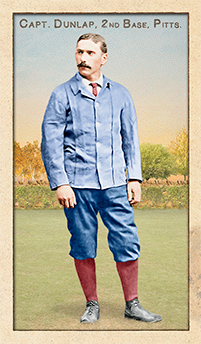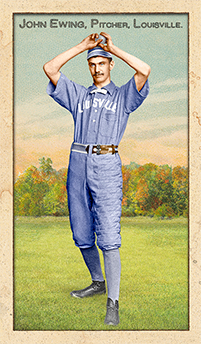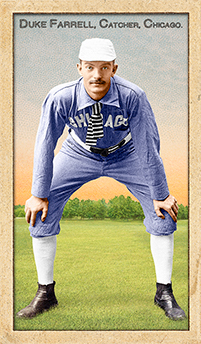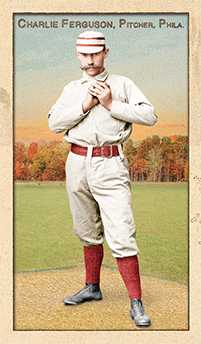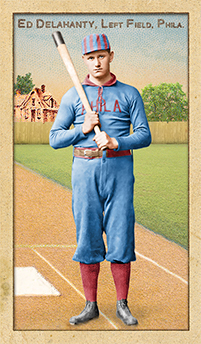
- Series: Beginnings: 1880's
- City: Philadelphia
- Team: Quakers
- League: National League
- Hall: National Baseball Hall of Fame
Edward James Delahanty (1867-1903) died in the icy waters of the Niagara River while still in his baseball prime. He was hitting .333 for the Senators that July of 1903, well below his days with the Phillies, but still a force to be reckoned with after a 16-year career in left field. Through the 1890s no hitter dominated as did Big Ed. With Sam Thompson and Billy Hamilton he formed an outfield-for-the-ages, each hitting .400+ in 1894. He struggled during his early years until, driven to excel, Ed transformed himself at the plate. Personal achievement had not brought a pennant, however, and Delahanty experienced the frustrations of the reserve system in his pursuit of the pay he felt was his due. As with so many players of that day, Ed turned to the bottle and was given to outbursts such as the one that got him ejected from the train the night he died. His tragic end came amid one of the great careers in baseball history.
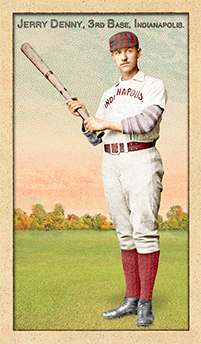
- Series: Beginnings: 1880's
- City: Indianapolis
- Team: Hoosiers (NL)
- League: National League
Jeremiah Dennis Denny (1859-1927) was a rare ambidextrous third baseman who played professionally for over 20 years, 13 in the majors. He was the last position player to play his entire career without a glove, which would have hindered his ability to use his left hand when the play required. Denny broke in with the Providence Grays and led them to the first inter-league post-season tournament championship as the NL beat the AA in 1884. Jerry teamed with Arthur Irwin at short to create a formidable combination on the left side. He won the first-ever “series” game with a three-run homer off Tim Keefe of the Metropolitans. Providence closed down and Jerry moved to the Maroons in St. Louis for a year and then on to Indianapolis when the team relocated. A reliable batter with good power, Denny compiled a .260 career average and 74 HRs.
- Holds the MLB record for chances by a third baseman in a game: 16 on 8/17/82
- Denny was a pseudonym, adopted while in college in Phoenix to mask his semi-pro forays that were barred to amateurs. His birth name was Eldridge

- Series: Beginnings: 1880's
- City: St. Louis
- Team: Browns (AA)
- League: American Association
James H. Devlin (1866-1900) was another of those Troy, NY (Lansingburgh) ballplayers to make an impact on the major leagues in the 19th century. The game was growing into a national pastime and Troy was at its center in the post-Civil War years when Devlin was born. He began with Syracuse of the International League in the spring of 1886, going 2-4 with a 1.05 ERA, which earned him a call-up to the NL's Giants that summer. He would continue to shuttle between major and minor league clubs for the next decade. His time in the big leagues included two more teams, the Philadelphia Quakers and the St. Louis Browns, then of the American Association. After the 1889 season in St. Louis, Devlin was out of baseball for a year before leading the Eastern League's Albany Senators with 26 wins in 40 decisions in '91. His MLB record was a mere 11-10, but he compiled a very respectable 3.38 ERA. Like so many before and since, Devlin fared much better in the minors. Jim would play in the Eastern and Pennsylvania Leagues through the mid-'90s and closed his professional career in the Canadian League, going 2-0 for London despite surrendering 14 runs. Every pitcher would pray for such support.
- All together Devlin won 106 games in the minors, including 21 with his hometown Troy Trojans
- Among many major leaguers to perish at too young an age, Devlin succumbed to typhoid fever at 34 back in Troy
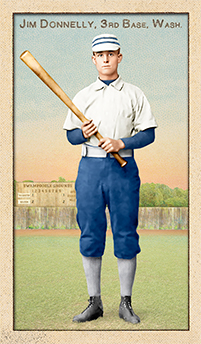
- Series: Beginnings: 1880's
- City: Washington, D.C.
- Team: Nationals
- League: National League
James B. Donnelly (1865-1915) had eleven seasons in the majors, playing third base for nine teams. While he toiled in relative obscurity for most of his career, Donnelly had the thrill, in its waning days, of being part of a remarkable championship season with the Orioles in 1896. In that storied year, the club walked away with its third straight NL pennant, besting second-place Cleveland to win the Temple Cup in the post-season. Donnelly had, by far, his greatest offensive production in ‘96, hitting .328 - over a hundred points above his lifetime average. That effort would have been a headliner for any other team, but in Baltimore Donnelly was only the sixth-best on the squad. Jim was overshadowed by pretty good men: Wilbert Robinson .347, Jack Doyle .339, Hughie Jennings .401, Willie Keeler .386, and Joe Kelley .364. Talk about Murderers Row! The Ned Hanlon/John McGraw powerhouse was soon to disband as the NL went from twelve to eight teams to accommodate the new American League a few years later.

- Series: Beginnings: 1880's
- City: Omaha
- Team: Omahogs
- League: Western Association
John S. Doran played for 6 minor league teams over 5 years. He was with the Quincy, IL, Quincies club of the Northwestern Association in 1883 and then shows up on the Eau Claire Lumbermen and Oshkosh teams in the same league in ’86 and ’87. At Oshkosh, Doran played for future Hall of Fame manager Frank Selee who went on to the majors in 1890. The following year Jack played for the Davenport Onion Weeders and the Omaha Omahogs of the Western Association. His final year was with Worcester of the Atlantic Association. Based on the limited documentation available, Doran’s finest year was with Selee’s squad where he hit .334 in 504 ABs and stole 18 bases.
- Doran got into 25 games for the ’88 Omahogs
- Based on the year he had in Oshkosh, it is curious that Selee didn’t take Jack to the Beaneaters
- Although the Old Judge series features two known poses of John Doran, I could not find one of suitable quality for this project. This image is taken from an Old Judge proof taken at the same time as Doran's other OJ images and may represent an as-of-yet undiscovered pose.
- Series: Beginnings: 1880's
- City: New York
- Team: Giants
- League: National League
Michael Cornelius Dorgan (1853-1909) was an outstanding hitter and fielder whose career (and life) was cut short by numerous injuries due to his aggressive play. He starred for the St. Louis Brown Stockings and ended with the Syracuse Stars, his hometown team. Surgery on his knee, hurt making a game-saving catch in 1887, led to blood poisoning and his premature death.
- First Syracuse resident to play in the NL
- Awarded the New York Clipper Gold Badge Award as top defensive player at his position
- Managed parts of 3 seasons for 3 different NL teams from 1879-1881
- Elected to Syracuse Hall of Fame: 1999
- Series: Beginnings: 1880's
- City: St. Louis
- Team: Browns (AA)
- League: American Association
Charles Edward Duffee (1866-1894) was an outfielder for four clubs from 1889 through 1893, beginning with the St Louis Browns for two seasons, then playing during one year each for the Columbus Solons, Washington Senators and Cincinnati Reds. That last assignment was very short-lived, as Duffee played only four games in April, 1893.
- Duffee’s career BA was .267 with 35 HRs and 33 triples
- “Home Run” Duffee hit 16 in his rookie season, third in the AA
- Duffee’s career was cut short by ill health, and he died of “consumption” Christmas Eve, 1894
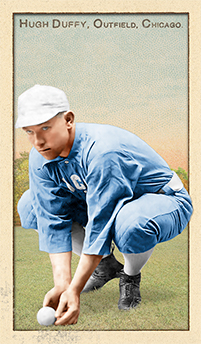
- Series: Beginnings: 1880's
- City: Chicago
- Team: White Stockings
- League: National League
- Hall: National Baseball Hall of Fame
Hugh Duffy (1866-1954) is as much a baseball institution as the Hall of Fame that enshrines him. For 68 years he devoted himself to the game he loved and excelled at as few ever have. In 1894 he set the all-time mark with a .440 average while winning the triple crown. He made HOF pitchers look like batting practice coaches: .586 against John Clarkson, .650 vs Cy Young. Amos Rusie was the exception, holding Duffy to a mere .333. So diminutive Cap Anson nearly dismissed him (“We already have a bat boy”), Hugh hustled his way to becoming the only player to hit .300 in four leagues and let the power follow his form (“hit ‘em up the middle”) winning two HR titles. Duffy went on to coach, manage, scout and mentor for a half-century after hanging up his spikes. He was still hitting fungoes eight years after his induction into Cooperstown and delighted in pupil Ted Williams’ success as he sought in vain to eclipse Duffy’s record in 1941.
- Playing career spanned 19 years, primarily in Chicago, Boston and Philadelphia
- Played center field for the Beaneaters next to his “Heavenly Twin,” Tommy McCarthy in right, leading Boston to a pair of pennants
- Elected to Hall of Fame: 1945
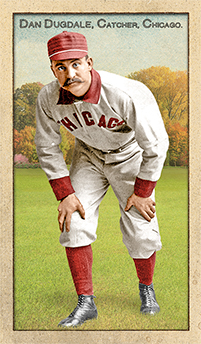
- Series: Beginnings: 1880's
- City: Chicago
- Team: Maroons
- League: Western Association
Daniel Edward Dugdale (1864-1934) had a brief exposure to major league baseball but carried the game’s torch to Seattle where he dominated the Pacific Northwest sports scene for 36 years until his sudden death crossing the street in front of a truck the night before his annual banquet celebrating the game. Big “Dug” had been a savvy catcher for the KC Cowboys and Washington Senators before migrating west seeking Klondike gold. He settled in Seattle where his devotion to baseball and his entrepreneurial instincts melded into a different kind of gold. He founded and managed teams, he built the first double-deck stadium on the coast, he was a warrior fending off the Pacific Coast League invaders from California. At last, he settled for being a legend in Rainier’s shadow, extolled at the banquet he missed as the Northwest’s “greatest individual figure in the national game.”
- When he decided to stop being the backup to Deacon McGuire in D.C., Dug went home to Peoria and founded the Distillers in what was then the world’s spirits capital
- Dugdale Park endured for decades until it perished two years before its owner, victim to a serial arsonist with an oil drum in the heart of the all-wood structure
- Series: Beginnings: 1880's
- City: Pittsburgh
- Team: Alleghenys
- League: National League
Frederick C. Dunlap (1859-1902) strode the heights of baseball throughout the 1880s as the “king of second basemen.” Highest-paid, adored by fans, sought by clubs who needed to win, the slick-fielding, sharp-eyed batsman could write his own ticket, and did. When Detroit (which had paid a record price to secure him from St. Louis) wanted to sell him to Pittsburgh, “Sure-Shot” demanded and nearly got half the proceeds. Despite never using a glove, this graceful fielder consistently ranked as the best at his position. In 1910, the founder of The Sporting News said he had seen them all and Dunlap was “the greatest that ever lived.” Yet his fall equaled his rise: forced out by a broken leg, a decade later his fortune was gone, as were his friends and health. “King Fred” died in 1902 “clean broke” without enough to carry his coffin.
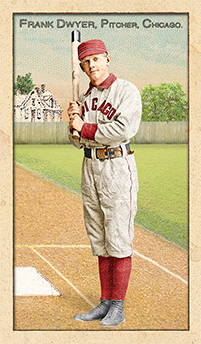
- Series: Beginnings: 1880's
- City: Chicago
- Team: Maroons
- League: Western Association
John Francis Dwyer (1868-1943) served MLB as player, manager and umpire. He won 176 games, led the NL in saves in 1893, piloted the ’02 Tigers and officiated Cy Young’s perfect game on May 5, 1904. The Massachusetts native was college-trained when he began his big league career in 1888 with Chicago’s White Stockings. Over his twelve year playing span, the right-hander completed 270 of his 318 starts. Dwyer’s hitting was good enough that he played four other positions, hit five HRs and compiled a .229 BA.
- Dwyer won over 15 games in nine of his twelve years including two 20+ seasons
- Dwyer was the workhorse on Kelly’s Killers (aka Cincinnati Porkers) during their 1891 AA season-still perhaps the rowdiest bunch in a wild era when franchises and whole leagues were forming and folding with abandon. Player-manager Mike “King” Kelly and owner Chris von der Ahe shared the conviction that beer and baseball were made for each other. That Dwyer could win 13 games under their leadership is a tribute to his athletic prowess.
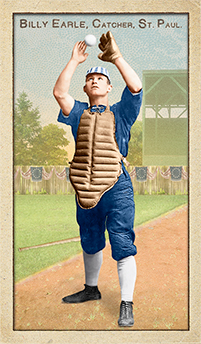
- Series: Beginnings: 1880's
- City: St. Paul
- Team: Apostles
- League: Western Association
William Moffat Earle (1867-1946) earned an outsized reputation in the game for a part-time catcher who never played more than 53 games in any of his 5 ML seasons. Long after his career ended, Bill Stern was spinning tales of how Billy was a victim of the superstitions of his day, pilloried for an “evil eye” that “creeped-out” his teammates. He began at the top of the profession, touring the world & photographed at the Great Pyramid with Al Spalding’s troupe, earning the moniker the Little Globetrotter. He was a good hitter and was lauded for his great potential during the 1889 world exhibition. That potential was never truly realized though, partly perhaps affected by Billy’s infatuation with the spirit world and hypnotism. His temperament was as erratic as his ML tenure, where he chronically jumped teams and fought over contracts.
- Had he played more, a lifetime career .286 BA certainly would have earned Earle a place on the catchers’ honor roll
- The “blacklist” insinuations are belied by Billy’s long minor league tenure and in Cuba, as player and manager
- Earle's uniform color in this card was changed from black to blue in August, 2017 to reflect recent reliable research conducted by Craig Brown and friends at Threads of Our Game. Seven cards were previously released featuring a black uniform
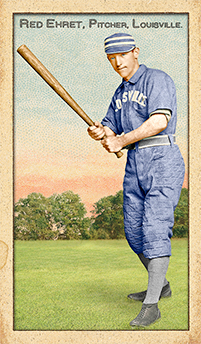
- Series: Beginnings: 1880's
- City: Louisville
- Team: Colonels
- League: American Association
Philip Sydney Ehret (1868-1940) made his major league debut while still only 19, in July 1888. A pitcher for six big league teams over 11 seasons through 1898, Red broke in with the Kansas City Cowboys and closed his tenure with his hometown Louisville Colonels. Overall, he achieved a 139-167 record with a 4.02 ERA. Young Ehret had a great year in 1890, winning 25 games for the Colonels with the second-best ERA in the American Association at 2.53. Only 29 when his major league career closed, Ehret returned to the minors for another six years finishing up in the Southern Association with the Memphis Egyptians for three seasons and, finally, with the Montgomery Senators in 1906 where he pitched only five innings.
- Pitched three games, winning two, in the 1890 post-season series which ended in a tie with Brooklyn, 3-3-1 after weather curtailed a planned nine-game event
- Led the NL in shutouts in 1893 with four
- Red was part of what became the longest streak of a team starting a different opening-day pitcher, 13 straight years in Cincinnati from 1892-1904, a record still unmatched. He was sixth in the skein

- Series: Beginnings: 1880's
- City: Indianapolis
- Team: Hoosiers (NL)
- League: National League
Thomas John Esterbrook (1857-1901) played third and first base for seven different teams over 11 professional seasons. In 1884, Esterbrook had a terrific year, compiling a .314 batting average, with 150 hits, 29 doubles, 11 triples, 110 runs and an OPS+ of 150 for Jim Mutrie’s New York Metropolitans of the American Association. By 1889, Dude was player/manager of the Louisville Colonels during one of the most dismal seasons in MLB history (27-111, the worst record in the AA’s existence). As the losses mounted, tempers rose and Esterbrook’s attempts to fine players met with rebellion. He lost his post to “Chicken” Wolf who replaced him only to face the first true players’ strike when owner Mordecai Davidson reinstated Dude’s levies. Ironically, Esterbrook set his career mark, hitting .318 that woeful campaign, albeit in a part time role. His lifetime average in the majors was .261.
- Esterbrook’s confrontational style, evident in his short tenure as a manager, signalled emotional trouble ahead. His life ended at the age of 43 when he jumped from a train that was transporting him to a psychiatric hospital
- The Dude abides
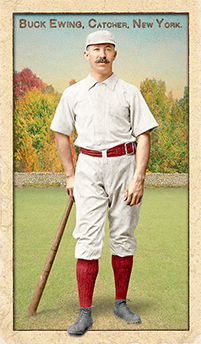
- Series: Beginnings: 1880's
- City: New York
- Team: Giants
- League: National League
- Hall: National Baseball Hall of Fame
William Ewing (1859-1906) was the premier catcher of the 19th century, honored for decades after his early death as even, perhaps, the greatest player of all time. A scourge at bat, Buck hit over .300 ten times. He played behind the plate with courage and style, crouching close to the hitter so as to shave precious seconds off his inerrant throws. Ewing had debuted with the remarkable Troy Trojans in 1880 and joined four future Hall-of-Famers in moving to NYC in ‘83. The sturdy catcher may have been the primary inspiration for Jim Mutrie’s “my Giants!” exclamation that led to the new identity of the Gothams. An arm injury on a raw spring day curtailed his tenure behind the plate from 1891 on. Such a magnetic figure couldn’t escape the turmoil of the Players’ League controversies and Ewing was sometimes pilloried for lax effort. Despite such caviling, Ewing left as indelible a mark on the game’s first century as anyone. Upon his induction to Cooperstown (among the first six of the “pre-modern” era), he was hailed by Connie Mack as the greatest catcher he had seen and he had seen most.
- “Buck” was a derivative of “Buckingham,” bestowed on the budding star by an admiring scribe who wanted to add gravitas to the youngster’s reputation
- Played all nine positions and managed 3 different teams over 7 seasons
- Was the first catcher elected to the Hall of Fame; and the second 19th century player elected (after Cap Anson)
- Elected to Hall of Fame: 1939
- Series: Beginnings: 1880's
- City: Louisville
- Team: Colonels
- League: American Association
John Ewing (1863-1895) had three early cups of coffee, playing 1 game in 1883 for the St Louis Browns, 1 game in ‘84 for the “Outlaw Reds” of the Union Association, and 1 game also in ’84 for the Washington Nationals of the UA. In that game, Long John had a triple and scored– the full extent of his offense until returning to MLB four years later. Ewing finally caught on as a pitcher in 1888 with the Louisville Colonels, playing there for 2 seasons before ending his career with the 1890 Giants of the Players’ League and their NL club in ’91 where he went out with a bang, earning the NL’s ERA title with 2.27. In all, Ewing played for six ML teams in four leagues during his brief career.
- Ewing’s brother Buck went on to a Hall of Fame career as infielder/manager
- The brothers were teammates for two seasons and John played under Buck as manager in ‘90
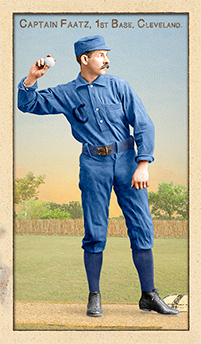
- Series: Beginnings: 1880's
- City: Cleveland
- Team: Blues (AA)
- League: American Association
Jayson S. Faatz (1859-1923) was a long, lean first-baseman with speed, spunk and the mouth of a drunken sailor. His brief tenure in the major leagues was marked by poor offensive output and notable regard by his bosses. Despite mediocre hitting stats and the temperament of a wounded wolverine, Jay was repeatedly chosen to lead his teammates on the field. He served as player-manager in the minors and majors and was a key ally of John Montgomery Ward in the creation of the Players' League. Faatz came out of the Canadian circuits to Pittsburgh's misbegotten American Association entry late in the 1884 season, getting into 29 games as the club finished 11th of 13. He last played in the PL after moving from Cleveland to Buffalo. A colorful sports reporter of the time, Ernest Jarrold, once described the inner machinations that produced the Players' League. He spoke of Faatz, with his 6'4” sub-200 lb frame as “one of the most striking figures” involved. He dubbed Faatz “the most expert poker player in the United States” with a passion for diamonds, which were always tucked on his person. He not only cut a dashing image but was a “level-headed, clear thinker, and the orator of the Brotherhood,” per Jarrold.
- Faatz' career average was as lean as the player: .241. Yet one of his three lifetime home runs was noteworthy. His grounder bounced off third-sacker Deacon White's foot and rolled under the stands, yielding a three-run “blast” that never left the infield, per David Nemec of SABR
- In one of those Old Judge idiosyncrasies, Goodwin's editors elected to identify Faatz as "Capt." on his three Old Judge entries while curiously omitting his defensive position. One might assume that this speaks to Faatz' reputation as more of a leader than a skilled ballplayer.
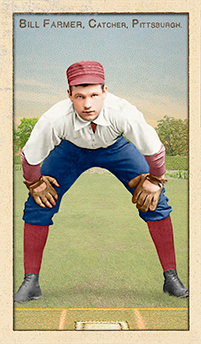
- Series: Beginnings: 1880's
- City: Pittsburgh
- Team: Alleghenys
- League: National League
William Charles Farmer (1864-1928) had a very brief major league career as a catcher for two teams in 1888. He played first for the Pittsburgh Alleghenys of the National League and got into two games with four at bats. He then moved across state to the Philadelphia Athletics of the American Association where he played in three games and got two hits in 12 plate appearances. He drove in one run. Such was the lot of this would-be big leaguer, a “career average” of .125. Bill did better when he moved west to the St. Paul Apostles in 1889. He was behind the plate for 28 of his 63 games and batted .272. He even showed some speed with 38 steals. He was on the team’s roster the following year but performance data is lacking. Similarly, for Farmer’s first minor league assignment in 1887 with the Shamokin Maroons in the Central Pennsylvania League, we know only that he was on the team.
- High Heat Stats has compiled a list of all the Emerald Isle-born players who made it to MLB. Farmer, of Dublin, is one of only 44 on that roll
- The Goodwin editors point out a somewhat mournful stat for Mr. Farmer: he was featured in more Old Judge card poses (5) than he had hits in his major league tenure (2)
- Series: Beginnings: 1880's
- City: Philadelphia
- Team: Quakers
- League: National League
Sidney Douglas Farrar (1859-1935) played his entire ML career in Philadelphia for the Quakers (Phillies) and Athletics. Farrar averaged .246 over his eight years. He started at 1B every year. As a rookie in 1883, he endured the fledgling franchise’s inaugural season with a NL-worst record of 17-81. He moved to the ill-starred Players’ League in 1890 and retired after the league folded.
- A devoted father, Farrar and his teammates scrimped to pay for his daughter Geraldine’s music education
- Geraldine went on to a world-renowned opera career, touring with Toscanini and Caruso
- Series: Beginnings: 1880's
- City: Chicago
- Team: White Stockings
- League: National League
Charles Andrew Farrell (1866-1925) was a much-beloved and highly touted catcher for 18 years. He played three years for Boston (AL), all pennant-winning clubs. Returning to Boston after a ten year absence, the Royal Rooters gave him a diamond ring on opening day. When the club played next in D.C., the Senators fans gave him “the greatest ovation a visiting player ever received on a Washington ball field.” And there was much to love: 1563 games, 1564 hits, 912 RBI. And Duke set a record that still stands, throwing out 8 of 9 attempted steals on May 11, 1897. Farrell earned praise at every stop in his nine-team career, with multiple stints with several of the clubs.
- Was reputed to have earned his nickname by consuming 380 clams
- After helping the Sox to the first world title in 1903, per Tim Murnane, Boston writer: “…Farrell is the greatest catcher the game has produced”
- Series: Beginnings: 1880's
- City: Washington, D.C.
- Team: Nationals
- League: National League
John A. Farrell (1857-1914). Known as Moose, Farrell played 2nd base for 5 teams over 11 seasons. Jack also served as player/manager for the 1881 Providence Grays and achieved a 24-27 record before quitting as the captain. A light hitter, Jack’s defense was excellent and he either led or finished near the lead in many defensive categories for second basemen throughout his career.
- Led NL in assists with 365 in 1883
- Led NL in assists for 2B twice: 1881 & 1883
- Led NL in double plays for 2B in 1883
- Led NL in FLDG% for 2B in 1883 with .924
- Ranks 26th all-time in range factor at 2B
- Farrell’s uniform color on this card was changed in April, 2017 from black to blue to reflect recent reliable research by Craig Brown & friends at Threads of Our Game. Six cards had been previously released featuring a black uniform.
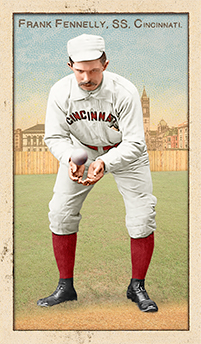
- Series: Beginnings: 1880's
- City: Cincinnati
- Team: Red Stockings (AA)
- League: American Association
Francis John Fennelly (1860-1920) came out of Fall River, MA to whack 34 career home-runs in the American Association. Not a bad sum for the era of flabby, misshapen baseballs. And, thanks to careful research, Frank’s effectiveness swinging a stout wooden implement does, indeed, exceed the prowess of his classmate and more famous hometown slugger, Lizzie Borden. Despite the scurrilous playground rhyme to the contrary, Lizzie used only about 30 blows to become the most famous self-made orphan in New England. Frank’s more prosaic career took him to Washington as a rookie with the Nationals in 1884 where he led the team in batting as their shortstop. He finished his debut year with Cincinnati where he hit .352 and earned his keep until traded to the Athletics during the ‘88 season. A brief stint with the Brooklyn Gladiators in 1890 concluded his major league experience. Overall, Fennelly’s BA was .257 with 175 stolen bases. He led the American Association in RBI (89) in 1885.
- The notorious axe murders occurred in 1892; two years after Frank returned home
- Frank was born six months before Lizzie, who outlived him by seven years
- Frank is buried in St. Patrick’s Cemetery; Lizzie is buried in Oak Grove Cemetery, next to her parents
- Series: Beginnings: 1880's
- City: Philadelphia
- Team: Quakers
- League: National League
Charles J. Ferguson (1863-1888) was considered by future Hall of Famer Wilbert Robinson to be the 5th best player of all-time when Ferguson succumbed to typhoid fever at age 25. Primarily a pitcher for the Quakers over four seasons, the right-hander also handled the outfield and second-base. He won at least 21 games each year and was lights-out in 1886, winning 30 with a 1.98 ERA (2nd in the league). Playing more outfield the next year, Ferguson not only won 22 but drove in 85 with a .327 average. The youngster was stricken before the ’88 season and never recovered.
- Hurled a no-hitter against the Providence Grays on Aug 29, 1885
- In tribute to this young warrior, the Quakers and three other NL teams wore black crepe for the entire 1888 season
- Decades later, W.B. Hanna dubbed him “the game’s best all around player”
- Robinson ranked Ferguson 5th all time after Cobb, Keeler, Ruth and Wagner
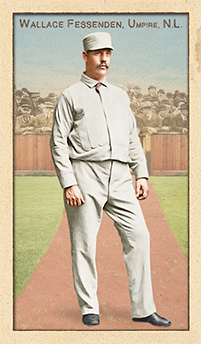
- Series: Beginnings: 1880's
- League: National League
Wallace Clifton Fessenden (1860-1935) was born in New Hampshire as the clouds of civil war were gathering. At age 28 he umpired in the National League, logging 52 games in 1889 and returning for one game in 1890. At the end of that season, Fessenden left his referee garb on July 2 and stepped in as the interim manager of the American Association's Syracuse Stars three weeks later. The team went 4-7 during his time at the helm. His ace that season was Dan Casey, who although not the real model for Mighty Casey, had the honor of reenacting Thayer's opus at the inauguration of the Hall of Fame in 1939. The best hitter on the Stars was Cupid Childs who hit .345. Wally followed George Kasson Frazier who, with Fessenden, shared the distinction of managing the Stars that year as their only major league managerial experience. Frazier was the team owner and stepped aside as the season wound down toward the dissolution of the club at year's end. The Stars had been an International Association team in 1888 and '89 before their sole MLB season in the AA.
- Fessenden had gained some minor league managerial experience with Lynn of the Massachusetts State Association in 1884 and with Salem of the New England League in 1888
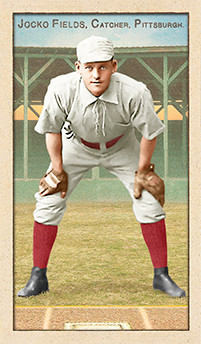
- Series: Beginnings: 1880's
- City: Pittsburgh
- Team: Alleghenys
- League: National League
John Joseph Fields (1864-1950) was named, by Hight Heat Stats, the starting left fielder for the All Emerald Isle Nine. This is, perhaps, less a tribute to Jocko than a commentary on the endeavors of Irish immigrants of the 19th century, who may have had more mundane occupations as they settled into their adopted land. Nevertheless, the list puts Fields in good company with Tommy Bond, Tony Mullane and Jack Doyle among the squad. Jocko was mostly a part-timer in the majors, starting with Pittsburgh's Alleghenys in 1887 where he played two more seasons. The uproar of labor strife in 1890 led to the Players' League founding and Fields tried his luck with the Burghers. Despite being led by Jake Beckley's formidable bat, the rest of the team didn't give much support and they languished in sixth place. Fields did have a decent year, hitting .281, well below his previous season's output when he hit .311. The PL did offer youngsters like Jocko more playing time, however, and he saw more action in '90 than any other campaign. He got into 126 games and drove in 86, nearly half of his six-year career total. He returned to the Pirates in '91 and was shipped to Philadelphia for a handful of games at the end of that season. A final try with the Giants in '92 lasted only 21 games and proved his swan song. Jocko's pro career had begun with the Jersey City Skeeters in 1885 followed by three NY teams in '86 before the Alleghenys called. He stayed in the game through the 1896 season for such teams as the Macon Hornets, Charleston Seagulls and Evansville Black Birds. He split his final tour between the Atlanta Crackers and Norfolk Braves. If nothing else, baseball provided a way for a young immigrant lad to really see the country.
- Fields' last few years in the minors saw him hit as well as he ever had. He averaged .351 for Charleston, and a combined .326 for those last two clubs in '96









